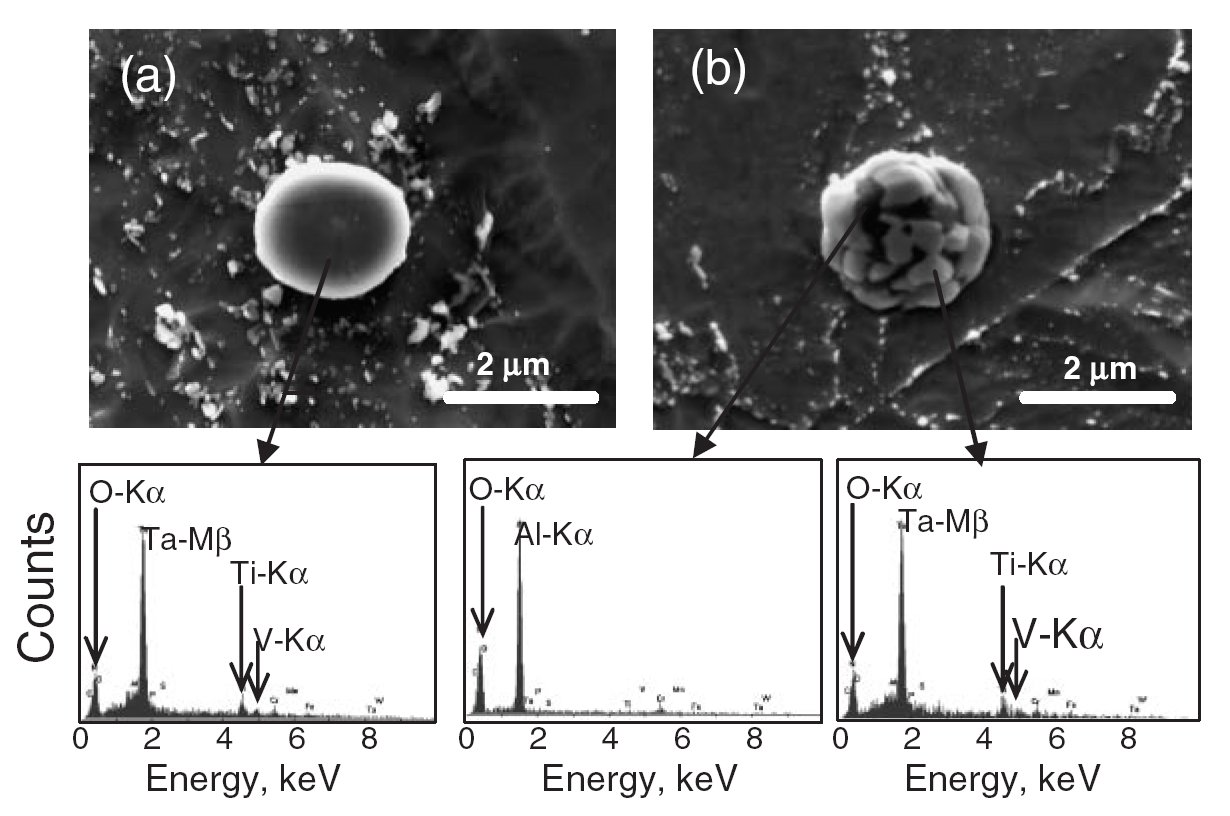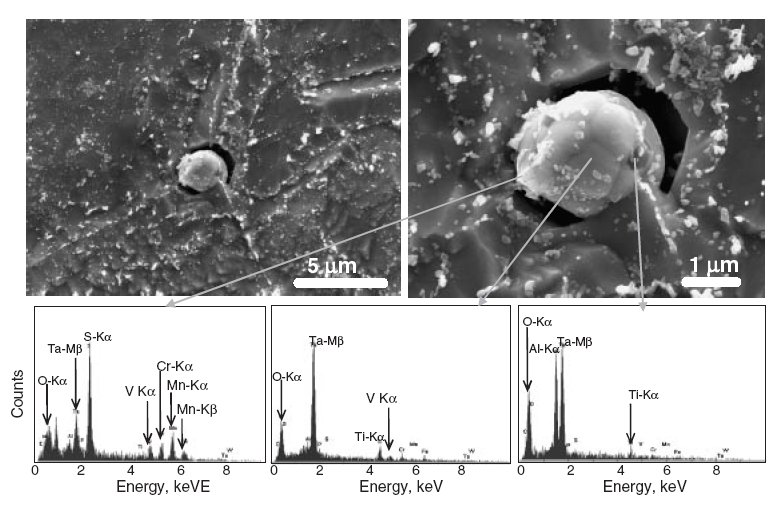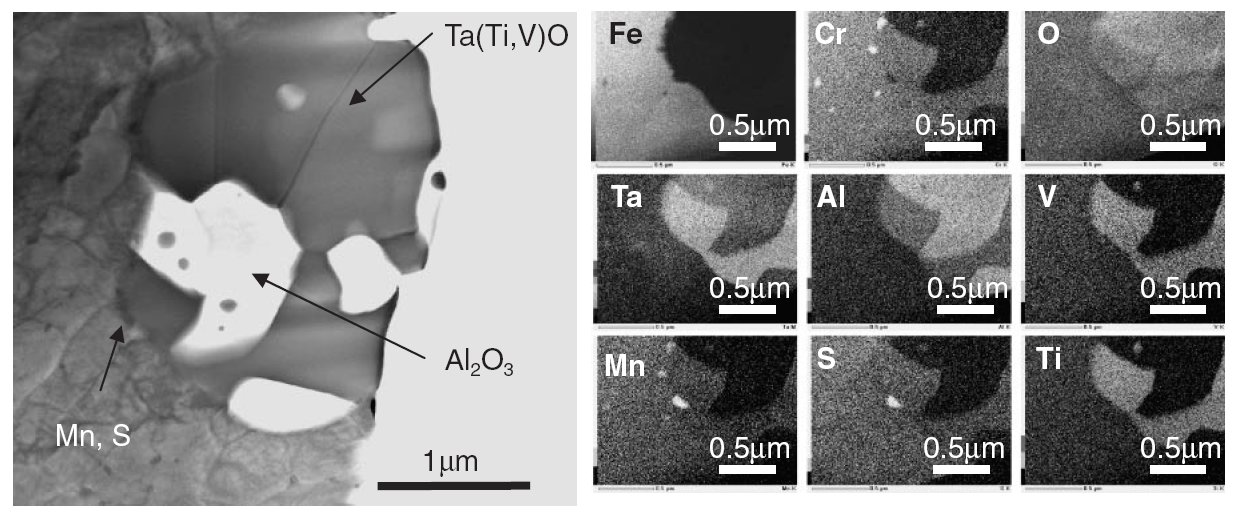
Alphabetical Index
Chemical Composition
Keyword Search
Named Inclusions
Steel Index
Exogenous Inclusions
Indigenous Inclusions
Macro Inclusions
Micro Inclusions
Nano Inclusions
Iron Oxide Inclusions
Nitride Inclusions
Oxide Inclusions
Phosphide Inclusions
Silicate Inclusions
Spinel Inclusions
Sulfide Inclusions
Refractory Inclusions
Slag Inclusions
Figure Browser
Help
Contact Us
Home
Non-metallic inclusions in F82H-IEA steel
Figure 1: SEM images for toughness-tested fracture surfaces and EDX spectra obtained from the oxides observed on the fracture-initiation positions. All specimens were obtained from plate no. 42W-1 tested at 173K and fractured at (a) 71.5MPa, (b) 75.2 MPa, and (c) 72.7 MPa. Scale bars: 10, 1 µm.
Figure 2: SEM images of (a) a single phase inclusion Ta(V)Ox, and (b) a composite inclusion, Al2O3-Ta(V,Ti)Ox. Bright contrasts correspond to Ta-rich regions, and dark contrasts correspond to Al-rich region, and typical EDX spectra obtained from these regions. Scale bars: 2 µm.
Figure 3: SEM images of the composite inclusions at prior-austenitic grain boundaries, with Mn- and S-rich compounds (a) at a lower magnification and (b) at a high magnification. Positions for EDS measurements are shown by the arrows. Scale bars: 5, 1 µm.
Figure 4: Cross sectional STEM bright-field images and EDS element mapping for composite oxides with Mn- and S- rich compounds. Scale bars: 1, 0.5 µm.
Inclusion name: Inclusions
Record No.: 1596
Inclusion formula: See the note.
Inclusion type (Macro/Micro/Nano): Micro
Inclusion type (Exogenous/Indigenous): Indigenous
Inclusion classification: Oxide, sulfide
Inclusion composition in weight %: No data
Sample: F82H-IEA steel. Heat treatment: 1313 K x 40 min + 1023 K x 1 h.
Steel composition in weight %: 0.1% C, 7.7% W, 2.00% V, 0.15% Ta, 0.02% Ti, 30 ppm N, 65 ppm O, 74 ppm Al, 10 ppm S
Note: Reduced activation ferritic/martensitic steels (RAFs) are recognized as the primary candidate structural materials for fusion blanket systems. F82H is the RAF which has been developed and studied in Japan, and F82H-IEA heat, one of the world’s first 5 ton heats of RAF, was provided and evaluated in various countries as a part of the IEA collaboration on fusion materials development. A problem with the steel is that some fracture toughness values obtained by 1T type of compact tension (1TCT) specimens showed very low values in ductile brittle transition region. There might be several reasons for the scatter, and one of them could be related to the microstructural inhomogeneity of F82H-IEA. In the present study, this possibility was investigated focusing on inclusions formed in a plate of F82H-IEA steel by scanning (SEM) and transmission electron microscopy (TEM) equipped with EDS.
The plates examined in this study were obtained from F82H-IEA heat no. 9753, nominally Fe-7.5Cr-2W-0.15V-0.02Ta-0.1C, in mass%. Analyses by SEM and TEM for the plates revealed that Ta does not form MX precipitates, but instead, it forms composite Al2O3 – Ta(V,Ti)O oxide, or single phase Ta(V)O oxide. The composite inclusions are rather dominant in the plate obtained from the bottom of the ingot, but not in the plate from the middle of the ingot. SEM observations also revealed that composite oxide tended to be observed at the crack-initiation site. These results suggest that the scatter of toughness values may be correlated with this microstructural inhomogeneity.
The surfaces of all specimens shown here have inclusions at its facture starting point. EDX analyses revealed that all of these are Ta- and Al-rich oxides and some of them show the presence of sulfur (Fig. 1).
SEM observations were performed on etched F82H plates obtained from different portions of the ingot, and the precipitates and inclusions were analyzed. It turned out that Ta does not form MX precipitates, but instead, it forms two types of oxide, one is composite oxides which are a mixture of Al2O3 and Ta(V,Ti)Ox [Al2O3-Ta(V,Ti)Ox], and the other is single phase oxides which are composed of Ta(Ti,V)Ox only (Fig. 2). The size distribution of these inclusions was analyzed on the region 1mm from the plate surface and t=2 section of the plate obtained from the middle of the ingot (no. 2W-4), and from the bottom of the ingot (no. 31W-3). The results revealed that number density of oxides are high in the region near the surface, regardless to the portion of the ingot from which the plate obtained. In the t=2 section of the plate, the composite oxides are rather dominant in the plate obtained from the bottom of the ingot, but not in the plate from the middle of the ingot. The single phase oxide is dominant in the t=2 section of the plate from the middle of the ingot. It was also revealed that those composite inclusions found on the prior austenitic grain boundaries tend to have Mn- and S-rich compounds on its surface (Fig. 3). The Mn and S-rich compounds are tend to found on the Ta(V,Ti)Ox part of composite inclusions. EDS mapping and TEM images suggests the presence of Mn- and S-rich compound on the intersection of boundary and Ta(V,Ti)Ox part of composite inclusions, and the compound do not include any other elements (Fig. 4).
Reference: Not shown in this demo version.